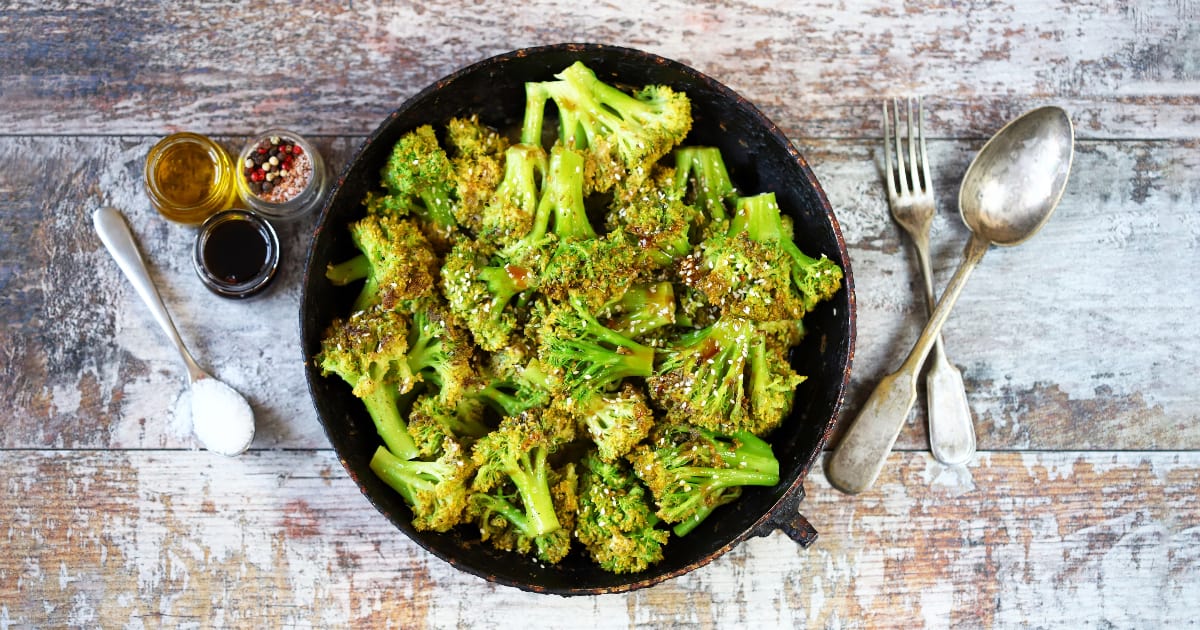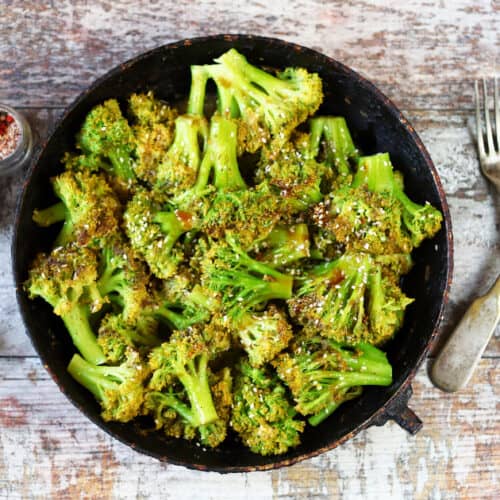Bored of plain old steamed broccoli? Give your veggie routine a flavor boost with this delicious Gochujang Sesame Broccoli recipe!
Gochujang, a staple condiment in Korean cooking, combines with aromatic sesame oil, zesty rice vinegar, and nutty sesame seeds to turn broccoli into an irresistible umami-rich side dish.

This easy broccoli recipe requires just minutes of prep time, making it a perfect quick weeknight side.
Gochujang 101
Before diving into the recipe, let's look at what exactly gochujang is and why it's so popular in Korean cuisine.
Gochujang is a thick, sticky fermented condiment made from chili peppers, glutinous rice, fermented soybeans, and sometimes sweeteners. It has a deep red color and a sweet, spicy, and umami-rich flavor profile.
Some key characteristics of gochujang include:
- Spicy and Sweet: The chile peppers bring heat while the rice and sweeteners create a subtle sweetness. The overall flavor is a complex harmony of spicy, sweet, and savory.
- Umami-Rich: The fermented soybeans bump up the savory, mouthwatering umami flavor. A little goes a long way in boosting umami.
- Thick and Sticky: Thanks to the glutinous rice, gochujang has an almost paste-like consistency. It beautifully coats ingredients it's paired with.
- Versatile: Gochujang can be used to season everything from stews, sautéed veggies, meat, and seafood to dressings, dips, and marinades. It's a true Korean kitchen staple.
Now that you understand what gochujang is, let's see how it can transform broccoli into a flavor sensation!
Gochujang Takes Broccoli from Bland to Bold
Broccoli is a nutritional powerhouse. But let's face it - on its own, it can be downright boring.
Steaming or roasting plain broccoli rarely yields anything exciting flavor-wise. That's why broccoli is often doused in cheese sauce or ranch dressing.
But with the right seasoning, broccoli can become a star ingredient. This is where gochujang works its magic.
When roasted broccoli is coated in sweet, spicy, and umami-packed gochujang, its flavor profile completely transforms.
The fermented savoriness of the gochujang balances out the vegetal broccoli flavor. Chili heat and a touch of sweet complement the nutty, charred notes developed during roasting.
Rice vinegar adds a tangy punch of acidity to brighten up the other flavors. Toasted sesame oil provides an earthy, nutty aroma that further rounds out the dish.
Finally, toasted sesame seeds sprinkled on top texturally complement the tender-crisp broccoli florets.
Taking a plain vegetable like broccoli and turning it into a flavor-packed dish is what gochujang does best. Let's get cooking!
Serving Suggestions
This flavorful broccoli pairs especially well with:
- Rice: Steamed white or brown rice is a classic companion to soak up the gochujang sauce.
- Noodles: Toss the broccoli with ramen, udon, or soba noodles for a quick noodle bowl.
- Chicken: The spicy-savory broccoli complements simply cooked chicken like seared breasts or baked thighs.
- Beef: Grilled or pan-seared steak is excellent next to the broccoli's richness.
- Fish: Delicate white fish like cod or halibut balances the broccoli's bolder flavors.
- Tofu: Baked, pan-fried, or sautéed tofu makes this a vegetarian main dish.
This versatile broccoli recipe works as an appetizer, side dish, main, or meal prep component. Get creative with how you serve it!
Customize Your Gochujang Broccoli
Part of the fun of this broccoli recipe is customizing it to your tastes. Try these variations:
- Add other veggies like snap peas, carrots, or red bell pepper to roast with the broccoli.
- Swap in cauliflower, Brussels sprouts, or asparagus for part or all of the broccoli.
- Mix in sesame seeds, almonds, or cashews for crunch.
- Finish with fresh herbs like cilantro, mint, or basil.
- Amp up the heat by adding an extra tablespoon of gochujang or sriracha.
- For less spice, use less gochujang or add a bit of honey or maple syrup.
- Substitute soy sauce or fish sauce for part or all of the rice vinegar.
Let your tastebuds guide you in making this broccoli recipe your own!
Storing and Reheating Leftovers
Like many dishes, this broccoli tastes best freshly made. But you can extend its lifespan by:
- Let it cool completely before storing to prevent condensation buildup.
- Storing in an airtight container in the fridge for up to 4 days.
- Reheat gently in a sauté pan with a splash of water to prevent drying out.
You can also refresh leftover broccoli by:
- Tossing with freshly cooked noodles or rice.
- Adding to a stir fry or fried rice.
- Serving over a bed of greens for a salad.
With a little creativity, leftovers of this gochujang broccoli will never go to waste!
More Delicious Ways to Use Gochujang
The uses for flavorful gochujang don't stop at broccoli! This Korean pantry staple can spice up all kinds of dishes like:
- Gochujang chicken wings: Toss fried chicken wings in a gochujang glaze.
- Gochujang salmon: Rub salmon fillets with gochujang before broiling or grilling.
- Gochujang eggs: Stir a spoonful of gochujang into scrambled eggs or a fried egg breakfast bowl.
- Gochujang roast vegetables: Toss potatoes, carrots, cauliflower, or other veggies with gochujang before roasting.
- Gochujang butter: Blend gochujang into softened butter for a quick flavor of compound butter.
- Gochujang mayo: Whisk gochujang into mayonnaise for a spicy sandwich spread or veggie dip.
With its sweet-spicy umami flavor, the possibilities are endless for recipes using gochujang!
FAQs
Is gochujang spicy?
Gochujang has a mild to moderate spicy heat depending on the brand. Start with less and add more to taste if you like extra heat.
Can I sub sriracha for gochujang?
Sriracha has a similar chili flavor but lacks the sweetness, thickness, and fermented taste of gochujang. For best results, use authentic Korean gochujang.
Can I use fresh garlic instead of minced?
Yes, you can substitute 2-3 cloves of crushed fresh garlic for the minced garlic.
How long does the broccoli need to roast?
The broccoli takes 20-30 minutes to roast until tender and lightly charred. Start checking at 20 minutes and continue roasting if needed.
Can I use another vegetable instead?
Absolutely! Cauliflower, Brussels sprouts, asparagus, and carrots would all be delicious in place of the broccoli.
Conclusion
Looking for a fast, flavorful way to jazz up boring broccoli? Whip up this easy gochujang sesame broccoli recipe!
With just a few pantry ingredients, you can transform broccoli from bland and forgettable to irresistibly spicy, nutty, and crave-worthy.

Gochujang Broccoli
Ingredients
- Broccoli florets - about 4 cups, cut into bite-sized pieces
- Gochujang sauce - 1 tablespoon
- Sesame oil - 1 tablespoon
- Rice vinegar - 1 tablespoon
- Garlic - 1 clove, minced
- Sesame seeds - 1 tablespoon for garnish
- Salt and pepper - to taste
Instructions
Roast the Broccoli
- Preheat your oven to 400°F. Line a baking sheet with parchment paper.
- Place the broccoli florets on the prepared baking sheet in a single layer, avoiding overcrowding.
- Roast for 20-30 minutes, flipping halfway through, until the broccoli is lightly charred and tender-crisp.
- While the broccoli roasts, make your gochujang sauce.
Make the Gochujang Sauce
- In a small bowl, whisk together the gochujang, sesame oil, rice vinegar, and minced garlic.
- Season to taste with salt and pepper.
- Set aside.
Toss the Broccoli with Sauce
- When the broccoli is done roasting, transfer it to a large bowl.
- Add the gochujang sauce and toss until the broccoli is evenly coated.
- Taste and adjust seasoning if needed
Finish with Sesame Seeds
- Transfer the sauced broccoli to a serving platter. Sprinkle the toasted sesame seeds over the top and serve!
- And that's it - your gochujang broccoli is ready to be devoured. The prep work is fast and hands-off roasting means you don't have to hover over a hot stove.

